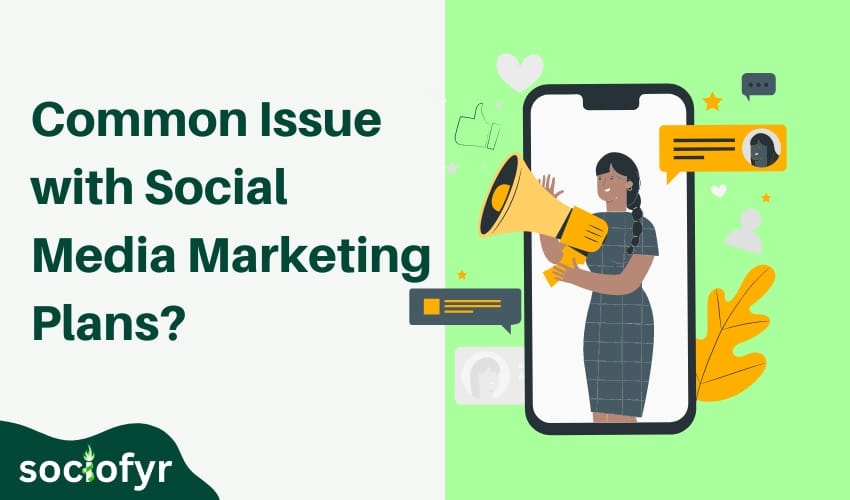What is a Common Issue with Social Media Marketing Plans?

In this digital world, social media has become a primary source of communication. Around five billion people use different social media platforms daily. With the passage of time, these platforms, considered to be a source of entertainment in one’s life, have become powerful sources of marketing campaigns. According to a study 76% of local businesses use social media marketing strategies, and 41% of them totally rely on these platforms to drive revenue.
However, maintaining an impactful presence is not that easy because what’s trending today will be forgotten soon, and it’s not about only posting stories occasionally on social media networks. So, what is a common issue with social media marketing plans?
Common issues include a lack of clear, well-defined strategies, ignoring public sentiment, quantity over quality, and irregular posting. These issues eventually result in low ROI (return on investment), loss of marketing budget and decreased popularity of your brand.
If you are a marketer and eager to learn practical based and action-oriented insights, get ready as we reveal more common problems faced with social media marketing and how to correct them. These result oriented insights will help you to avoid making common mistakes and enhance your social media marketing strategy for better results.
8 Common Problems in Social Media Marketing Strategies

There are plenty of problems that a brand or a marketer can face in social media marketing; here, I am listing the 8 most common problems based on our personal experience and endorsed by hundreds of marketers.
- Failure to understand Targeted Audience
- No defined goals
- Same content across platforms
- Inconsistent posting schedule
- Not staying updated with growing trends
- Neglecting Visual Content
- Failure to address negative feedback
- Quantity over quality
♦ Failure to Understand Targeted Audience
Understanding the target audience is the first step of a successful social media marketing campaign. Many brands post generic content without understanding demographics, interests, pain points and needs of their audience, which result in low engagement and loss of marketing budget.
You can easily get an idea of user interest and growing trends as social media platforms provide you with essential tools to track your audience and their engagement with top content. Additionally, there are many free or paid tools like Buffer and Hootsuite, which provide you complete knowledge of your audience and suggest relevant content ideas to streamline your marketing campaigns.
There are also built-in social media tools, such as Facebook Insights and Instagram Analytics, that provide valuable information on targeted audience demographics, activity patterns, and engagement preferences. Based on these insights, you can easily optimize your strategies to clearly hit the pain points of your audience and eventually draw you traffic.
♦ No defined goals
One of the most common issues with social media marketing plans that companies lack a clear roadmap and goals. Without a defined goal, they tend to post irrelevant stuff without a purpose across the social media platforms that do not resonate with the needs of their customers.
Although social media provides you with a market of billions of people, just posting content without a proper roadmap will not draw traffic to your social media. Trends easily grow and change with even greater speed, so matching the pace and craft your content according to that is key to a successful result oriented marketing strategy.
To overcome this problem, companies must establish clear objectives and set goals to achieve in a particular span of time, such as
- Increasing social media by x percentage
- Improved engagement rates
- Driving a set amount of website traffic
These goals will help you craft a better marketing strategy to achieve your goals. Keep tracking your performance with analytics tools to check your progress.
♦ Same Content Across Platforms
A lack of awareness of how different social media networks function results in low engagement. There are plenty of social media platforms and each platform offers unique features and particular audience base. For example, TikTok is a growing visual content platform that is mostly used by people under thirty years of age, meaning that you cannot post content that does not meet their needs.
Similarly, X (twitter) is more of a text based content sharing platform used by an audience of mostly adults. These ever evolving platforms require brands and marketers to stay informed about the latest trends and platform updates to best use of these powerful tools for marketing.
Each platform offers a different horizon of audience and requires customized content for each platform. To maximize the benefits, businesses should first access the product and service they are offering and which platform will suit their content. For example, LinkedIn can be a good option for business-to-business (B2B0 engagements, while YouTube, Instagram, and TikTok can be effective in targeting younger demographics with appealing visual content.
♦ Inconsistent posting schedule
Social media networks tend to promote those channels by posting regular content. Moreover, without a regular posting schedule, brands risk losing their follower interest and engagement, and this is one of the major problems businesses lose their user engagement with their social media handles, which results in low traffic and leads.
To tackle this issue, companies should make a content plan of what to post and a content calendar of when to post. This will naturally ensure regular content uploading helping to build and sustain an active online community and maximize the social media marketing efforts.
♦ Not staying updated with growing trends.
Search engines and social media networks are continuously evolving with new and enhanced features, algorithms, and user behaviours. For example, as of 2024, the following platforms went through updates:
- TikTok: New update favourites short-form video content and creative trends
- Instagram: New shopping feature and expanded Reels capabilities
- Facebook: Increased focus on community building with new group features
- LinkedIn: Improved B2B tools, new features for content sharing and professional networking
- Twitter (X): Updated interface and new content discovery feature
- Snapchat: New Augmented Reality (AR) features and tools for the creator
These new updates provide an opportunity for new content creators and marketers to make an impact. However, existing marketers failing to adapt to these trends means that they are missing out on an opportunity to engage with their audience effectively.
To cope up with these evolving trends, marketers should adapt the updating features and tailor their content according to new updates to stay ahead of competitors.
♦ Neglecting Visual Content
Effective visual content not only attracts users but also makes it easy for them to understand your offerings. Posts with appealing images and videos are more likely to be shared, commented, and liked by the users leading to increase reach and user interaction.
You can easily make attractive visual media for free with the help of many apps and websites offering free templates and resources. So, make sure you do add compelling media along with the textual content in your posts.
♦ Failure to address negative feedback
Many people when buying a service or new product, they do a lot of research about it. As social media is a platform for open dialogue and people give their feedback on particular services. However, ignoring or mishandling negative feedback can lead to a loss of trust and customer loyalty.
Additionally, leaving a bad review or comment unanswered discourages new customers from trusting your brand and reduces sustainability. On the other hand, when businesses take responsibility for public sentiment and demonstrate a commitment to customer satisfaction.
By acknowledging concerns, providing possible solutions, and showing empathy, you can convert a negative review into an opportunity to improve your offerings. Addressing negative feedback publicly and offering compensation shows that your brand values its customers’ opinions, which creates a humanized brand image and increases a loyal fan base.
♦ Quantity Over Quality
Focusing on producing large quantities of content at the expense of quality is a common problem in social media marketing. Regular publishing does help in increased visibility, but posting quality content engages your audience and fosters meaningful interactions.
Low-quality content often leads to low engagement, as users are less likely to share, comment, or even take notice of content that does not provide value. So, instead of uploading tons of irrelevant posts only for the sake of staying active, brands should focus on providing high-quality and visually appealing content that meets user interests and answers their pain points.
How Common Social Media Marketing Issues Affect Your Business

Social media marketing issues, when left unsolved, result in a waste of time, money, and the reputation of the brand. Mishandling or overlooking these challenges can lead to missed opportunities and reduced brand credibility. Mishandling or overlooking these challenges can lead to missed opportunities and lower return on investment (ROI). Here’s how these frequent challenges can impact your business:
- Low User Engagement
- Negative Brand Perception
- Missed Revenue
- Ineffective Use of Budget
A badly crafted social media campaign or relying on outdated marketing techniques can waste advertising dollars. However, study shows that with the right strategies businesses can achieve up to a 4.7x return on investment (ROI) on paid social media campaigns.
Correcting Mistakes in Social Media Marketing
Whether you are stepping in, or you are an existing social media marketer, the following tips will help you to streamline your social media marketing campaigns
Content Plan
- Define the objectives and goals of your social media marketing, such as increasing followers, driving traffic or increasing revenue
- Understand your audience by researching and analyzing their preferences and growing trends
- Make sure of the message you want to convey to your audience
- Select the content type and select a suitable social media network for that content
Content Calendar
- Make a calendar with dates and times for each post
- List down details that content will be including (text, images, videos or infographics)
- Assign responsibilities to team members
- Track key events like holidays or product launches to pre-plan relevant content
- Update the calendar regularly with new posts and adjustments to the schedule
Effective Handling of Negative Feedback
- Develop a response strategy for monitoring public sentiment and addressing it effectively
- Must respond to comments and queries to show responsiveness
- Approach negative feedback with empathy and provide compensation and productive solutions
Focus on Quality Content
- Prioritize high-quality, visually appealing content over a high volume of irrelevant content
- Analyze content performance using analytics to understand user’s interests and pain points
- Refine your future content based on performance data and analytics
- Avoid over-posting low-quality content
Stay Updated with Trends
- Educate yourself about the latest updates and trends through news blogs and forums
- Regularly update your content to incorporate current trends
- Monitor new changes to social networks’ algorithms
Conclusion
Understanding what is a common issue with social media marketing plans is essential for developing a successful strategy. One of the most common problems is lack of objectives and roadmap. Without a well-organized content plan with regularly scheduled posting across social media platforms, businesses struggle to maintain regular interaction with their audience.
To overcome these common issues, it is important to establish a clear content plan that defines your objectives and audience. You can use built-in tools in social media platforms such as Facebook Insights and Instagram Analytics or paid tools such as Hootsuite to identify your targeted audience.
Additionally, addressing negative feedback promptly, focusing on high-quality content, and staying updated with social media trends are vital steps in refining your marketing strategy.
FAQs
What is a common issue with social media marketing plans?
The most common issue is inconsistent posting schedules without a clear content plan or calendar. Businesses often lack the ability to post high quality content on a consistent basis which results in low visibility and interaction with targeted audiences.
How can I improve my social media marketing campaigns?
You can improve your strategy by making a content plan with clear objectives, a content calendar to streamline regular posting, and staying updated with latest updates and trends in your niche.
Why is social media an important part of inbound marketing?
Social media provides a platform with millions of active users all the time which enhances the chances of more visibility of your brand, engaging directly with the audience, and driving traffic to websites.
How does social media increase business return on investment (ROI)?
Social media increases ROI by targeting specific audiences, reducing advertising costs, and using data-driven insights to optimize marketing campaigns.